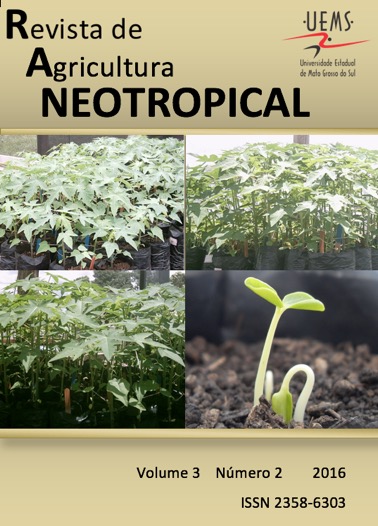EFFICIENCY LOSS OF RECORDED FUNGICIDES FOR THE CONTROL OF ASIAN SOYBEAN RUST IN CENTRAL REGION OF BRAZIL
DOI:
https://doi.org/10.32404/rean.v3i2.1066Abstract
Due to grower allege of low efficiency of triazole fungicides in recent years in Central Brazil on the control of Asian soybean rust (Phakopsora pachyrhizi), this study was undertaken to demonstrate the efficiency loss of products registered for rust and applied alone and to evaluate the efficiency of fungicides mixtures. The trials were carried out in five locations in Brazil, in the 2009/10 growing season. The experimental design was completely randomized blocks with four replications. Ten mixtures of triazole + strobilurin and two applications of pure triazoles were evaluated and the control without application. The application of fungicides started in the R1/R2 stage or in any vegetative stage if infections occurred early. The mixtures of fungicides were effective in controlling Asian soybean rust. Application of sole triazole fungicides was less effective in controlling the rust than the mixtures of triazoles + strobilurins. The use of commercial mixtures of triazole with strobilurin for rust control is recommended.
References
(1) AGRIOS, G. N. Planta pathology. Florida: Department of Plant Pathology, 2005. 903 p.
(2) ALMEIDA, A. M. R.; FERREIRA, L. P.; YORINORI, J. T.; SILVA, J. F. V.; HENNING, A. A.; GODOY, C. V.; COSTAMILAN, L. M.; MEYER, M. C. Doenças da soja (Glycine max). In: KIMATI, H.; AMORIM, L.; REZENDE, J. A. M.; FILHO, A. B.; CAMARGO, L. E. A. (Ed.). Manual de Fitopatologia. 4. ed. São Paulo-SP: Agronômica Ceres Ltda, 2005, v. 2. Doenças das plantas cultivadas, cap. 2, p. 569 - 588.
(3) AZEVEDO, L. A. S. D. Fungicidas orgânicos derivados de substâncias naturais. In: AZEVEDO, L. A. S. D. (Ed.). Fungicidas Protetores: Fundamentos para uso racional. Campinas-SP: 2003, p. 312.
(4) BERGAMIN FILHO, A.; KIMATI, H.; AMORIN, L. Controle químico. In: Manual de Fitopatologia: Princípios e conceitos. 3. ed. São Paulo-SP: 1995, v. 1, p. 761-785.
(5) EMBRAPA. EMPRESA BRASILEIRA DE PESQUISA AGROPECUÁRIA. Tecnologias de produção de soja Região Central do Brasil 2011. Londrina-PR: Embrapa Soja, 2010.
(6) EMBRAPA. EMPRESA BRASILEIRA DE PESQUISA AGROPECUÁRIA. Tecnologias de produção de soja Região Central do Brasil 2003. Londrina-PR: Embrapa Soja, 2003.
(7) GODOY, C. V.; KOGA, L. J.; CANTARI, M. G. Diagrammatic scala for assessment of soybean rust severity. Fitopatologia Brasileira, Brasília-DF, v. 31, n. 1, p. 63-68, 2006.
(8) HIRAKURI, M. H.; LAZZAROTTO, J. J. O agronegócio da soja nos contextos mundial e brasileiro. Documentos 349. Londrina-PR: Embrapa Soja, 2014.
(9) MENEGHETTI, R. C.; BALARDIN, R. S.; CORTE, G. D.; FAVERA, D. D.; DEBONA, D. Avaliação da ativação de defesa em soja contra Phakopsora pachyrhizi em condições controladas. Ciência Agrotécnica, Lavras-MG, v. 34, n. 4, p. 823-829, 2010.
(10) MILES, M. R.; LEVY, C.; MOREL, W.; MUELLER, T.; STEINLAGE, T.; VAN RIJ, N.; FREDERICK, R. D.; HARTMAN, G. L. International Fungicide Efficacy Trials for the Management of Soybean Rust. Plant Disease, St. Paul-USA, v. 91, n. 11, p. 1450-1458, 2007.
(11) MIO, L. L. M. D.; RUARO, L. Métodos de avaliação da ferrugem do álamo e eficiência de fungicidas no seu controle. Revista Árvore, Viçosa-MG, v. 32, n. 5, p.837-844, 2008.
(12) NAVARINI, L.; DALLAGNOL, L. J.; BALARDIN, R. S.; MOREIRA, M. T.; MENEGHETTI, R. C.; MADALOSSO, M. G. Controle químico da ferrugem asiática (Phakopsora pachyrhizi Sidow) na cultura da soja. Summa Phytopathologica, St. Paul-USA, v. 33, n. 2, p. 182-186, 2007.
(13) REIS, E. F. D.; NETO, V. D. C. L.; GODOY, C. V.; ROSA, C. T.; CASTANHO, H. E.; VICENTE, N. G. Controle químico da ferrugem asiática da soja na região Sul do Paraná. Scientia Agrária, Curitiba-PR, v. 8, n. 3, p. 319-323, 2007.
(14) SCHERM, H.; CHRISTIANO, R. S. C.; ESKER, P. D.; DEL PONTE, E. M.; GODOY, C. V. Quantitative review of fungicide efficacy trials for managing soybean rust in Brazil. Crop Protection, Queensland-Australia, v. 28, n. 9, p. 774-782, 2009.
(15) SILVA JÚNIOR, J.; REZENDE, P. M. D.; CARVALHO, E. D. A.; ALVES, E.; POZZA, E. A. Efeito de fungicidas sistêmicos e protetores aplicados em diferentes estádios fenológicos no controle da ferrugem asiática da soja. Ciência e Agrotecnologia, Lavras-MG, v. 33, n. 3, p. 705-712, 2009.
(16) SILVA, V. A. S.; JULIATTI, F. C.; SILVA, L. A. S. Interação entre resistência genética parcial e fungicidas no controle da ferrugem asiática da soja. Pesquisa Agropecuária Brasileira, Brasília-DF, v. 42, n. 9, p. 1261-1268, 2007.
(17) TERAMOTO, A.; MARTINS, M. C.; FERREIRA, L. C.; CUNHA, M. G. Reação de híbridos, inibição in vitro e controle da mancha alvo em pepino. Horticultura Brasileira, Brasília-DF, v. 29, n. 3, p. 342-348, 2011
Downloads
Published
How to Cite
Issue
Section
License
The authors retain the rights to the manuscripts and, therefore, are free to share, copy, distribute, perform and publicly communicate the work under the following conditions:
Acknowledge work credits in the manner specified by the author or licensor (but not in a way that suggests that you have their support or that they support their use of their work).
REVISTA DE AGRICULTURA NEOTROPICAL (ISSN 2358-6303) is under license https://creativecommons.org/licenses/by/4.0/
The State University of Mato Grosso do Sul, Sustainable Development Center of Bolsão Sul-Mato-grossense (CEDESU), of the University Unit of Cassilândia (UUC), preserves the patrimonial rights (copyright) of the published works and favors and allows their reuse under the license as mentioned above.
------------
The journal reserves the right to make normative, orthographic, and grammatical alterations in the originals, to maintain the cult standard of the language, respecting, however, the style of the authors.
Final proofs will be sent to the authors.
Published works become the property of the journal. The opinions expressed by the authors of the manuscripts are their sole responsibility.

